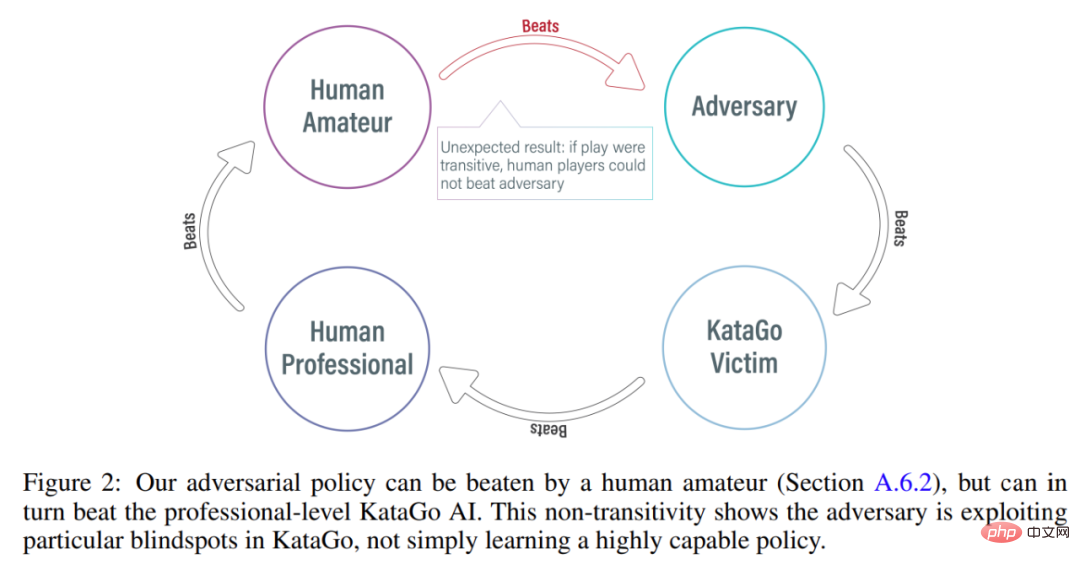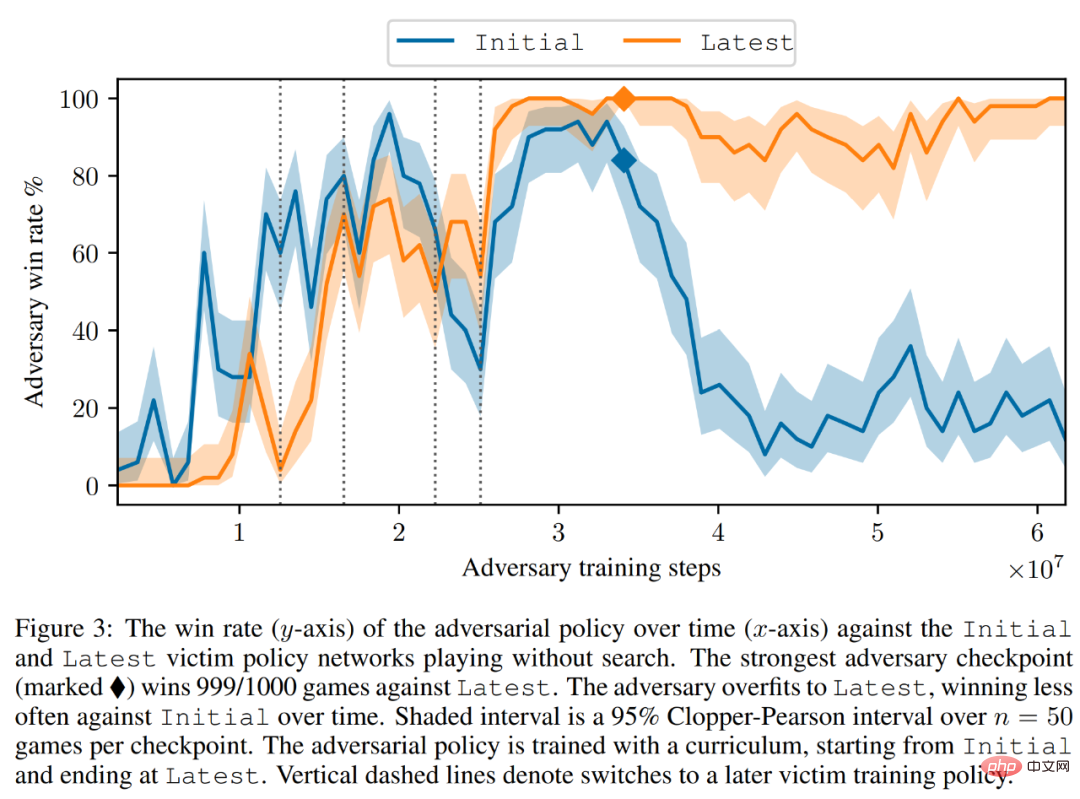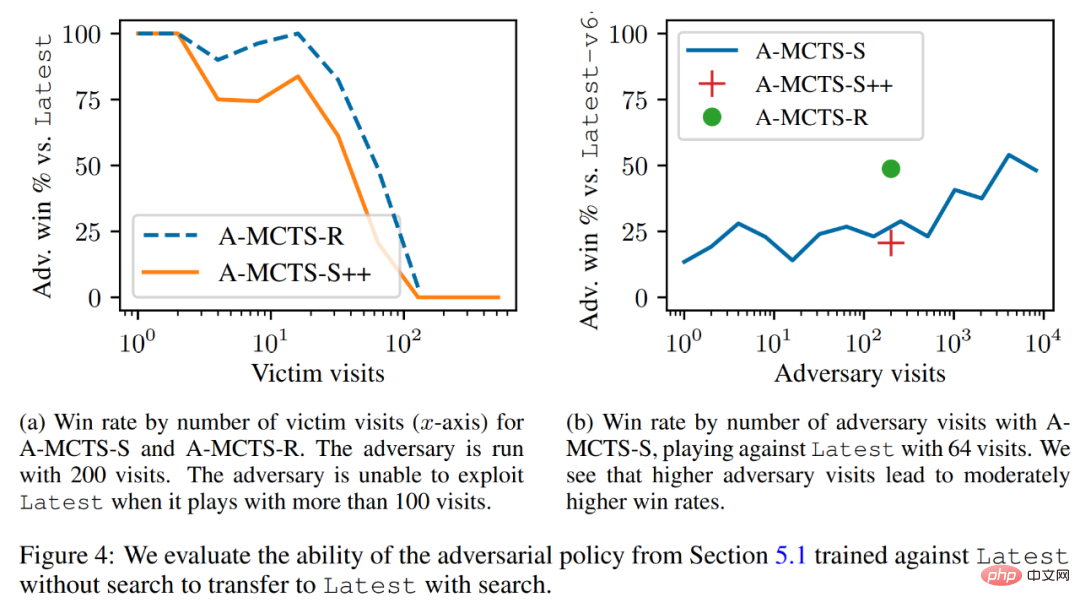 Technology peripherals
Technology peripherals
 AI
AI
 Use magic to defeat magic! A Go AI that rivaled top human players lost to its peers
Use magic to defeat magic! A Go AI that rivaled top human players lost to its peers
Use magic to defeat magic! A Go AI that rivaled top human players lost to its peers
In recent years, reinforcement learning in self-game has achieved superhuman performance in a series of games such as Go and chess. Furthermore, the idealized version of self-play also converges to a Nash equilibrium. Nash equilibrium is very famous in game theory. This theory was proposed by John Nash, the founder of game theory and Nobel Prize winner. That is, in a game process, regardless of the other party's strategy choice, one party will choose a certain strategy. strategy, the strategy is called a dominant strategy. If any player chooses the optimal strategy when the strategies of all other players are determined, then this combination is defined as a Nash equilibrium.
Previous research has shown that the seemingly effective continuous control strategies in self-game can also be exploited by countermeasures, suggesting that self-game may not be as powerful as previously thought. This leads to a question: Is confrontational strategy a way to overcome self-game, or is self-game strategy itself insufficient?
In order to answer this question, researchers from MIT, UC Berkeley and other institutions conducted some research. They chose a field that they are good at in self-games, namely Go. Specifically, they conducted an attack on KataGo, the strongest publicly available Go AI system. For a fixed network (freezing KataGo), they trained an end-to-end adversarial strategy. Using only 0.3% of the calculations when training KataGo, they obtained an adversarial strategy and used this strategy to attack KataGo. In this case, their strategy achieved a 99% winning rate against KataGo, which is comparable to the top 100 European Go players. And when KataGo used enough searches to approach superhuman levels, their win rate reached 50%. Crucially, the attacker (in this paper referring to the strategy learned in this study) cannot win by learning a general Go strategy.
Here we need to talk about KataGo. As this article says, when they wrote this article, KataGo was still the most powerful public Go AI system. With the support of search, it can be said that KataGo is very powerful, defeating ELF OpenGo and Leela Zero, which are superhuman themselves. Now the attacker in this study has defeated KataGo, which can be said to be very powerful.

Figure 1: Adversarial strategy defeats KataGo victim.

- Paper address: https://arxiv.org/pdf/2211.00241.pdf
- Research homepage: https://goattack.alignmentfund.org/adversarial-policy-katago?row=0#no_search-board
Interestingly, the adversarial strategy proposed in this study cannot defeat human players, and even amateur players can significantly outperform the proposed model.
Attack method
Previous methods such as KataGo and AlphaZero usually train the agent to play games by itself, and the game opponent is the agent itself. In this research by MIT, UC Berkeley and other institutions, a game is played between the attacker (adversary) and fixed victim (victim) agents, and the attacker is trained in this way. The research hopes to train attackers to exploit game interactions with victim agents rather than just imitating game opponents. This process is called "victim-play".

In conventional self-game, the agent models the opponent's actions by sampling from its own policy network. This approach does work. In the game of self. But in victim-play, modeling the victim from the attacker's policy network is the wrong approach. To solve this problem, this study proposes two types of adversarial MCTS (A-MCTS), including:
- A-MCTS-S: In A-MCTS-S, the researcher sets the attacker's search process as follows: when the victim moves the chess piece, sample from the victim's strategy network; When it is the attacker's turn to move a piece, samples are taken from the attacker's policy network.
- A-MCTS-R: Since A-MCTS-S underestimates the victim's ability, the study proposes A-MCTS-R, in the A-MCTS-R tree Run MCTS for the victim on each victim node. However, this change increases the computational complexity of training and inference for the attacker.
During training, the study trained adversarial strategies against games against frozen KataGo victims. Without search, the attacker can achieve >99% win rate against KataGo victims, which is comparable to the top 100 European Go players. Furthermore, the trained attacker achieved a win rate of over 80% in 64 rounds played against the victim agent, which the researchers estimate was comparable to the best human Go players.
It is worth noting that these games show that the countermeasures proposed in this study are not entirely gaming, but rather deceiving KataGo into positioning in a position favorable to the attacker. End the game early. In fact, while the attacker was able to exploit gaming strategies comparable to those of the best human Go players, it was easily defeated by human amateurs.
In order to test the attacker's ability to play against humans, the study asked Tony Tong Wang, the first author of the paper, to actually play against the attacker model. Wang had never learned the game of Go before this research project, but he still beat the attacker model by a huge margin. This shows that while the adversarial strategy proposed in this study can defeat an AI model that can defeat top human players, it cannot defeat human players. This may indicate that some AI Go models have bugs.
Evaluation results
Attack Victim Policy Network
First, the researchers evaluated themselves The attack method was evaluated on the performance of KataGo (Wu, 2019), and it was found that the A-MCTS-S algorithm achieved a winning rate of more than 99% against the search-free Latest (KataGo's latest network).
As shown in Figure 3 below, the researcher evaluated the performance of the self-confrontation strategy on the Initial and Latest policy networks. They found that during most of the training, the self-attacker achieved a high winning rate (above 90%) against both victims. However, as time goes by, the attacker overfits Latest, and the winning rate against Initial drops to about 20%.
The researchers also evaluated the best counter-strategy checkpoints against Latest, achieving a win rate of over 99%. Moreover, such a high win rate is achieved while the adversarial strategy is trained for only 3.4 × 10^7 time steps, which is 0.3% of the victim time steps.

Migrate to victims with searches
Researchers will The adversarial strategy was successfully transferred to the low search mechanism, and the adversarial strategy trained in the previous section was evaluated for its ability to search Latest. As shown in Figure 4a below, they found that A-MCTS-S’s win rate against victims dropped to 80% at 32 victim rounds. But here, the victim does not search during training and inference.

In addition, the researchers also tested A-MCTS-R and found that it performed better, with 32 victim rounds. Latest achieved a win rate of over 99%, but at round 128 the win rate dropped below 10%.
In Figure 4b, the researchers show that when the attacker comes to 4096 rounds, A-MCTS-S achieves a maximum winning rate of 54% against Latest. This is very similar to the performance of A-MCTS-R at 200 epochs, which achieved a 49% win rate.
Other evaluation
As shown in Figure 9 below, the researchers found that although Latest is a more powerful intelligence body, but the attacker trained against Latest performs better against Latest than Initial.

Finally, the researchers discussed the attack principle, including victim value prediction and hard-coded defense evaluation. As shown in Figure 5 below, all baseline attacks perform significantly worse than the adversarial strategies they were trained on.

Please refer to the original paper for more technical details.
The above is the detailed content of Use magic to defeat magic! A Go AI that rivaled top human players lost to its peers. For more information, please follow other related articles on the PHP Chinese website!

Hot AI Tools

Undresser.AI Undress
AI-powered app for creating realistic nude photos

AI Clothes Remover
Online AI tool for removing clothes from photos.

Undress AI Tool
Undress images for free

Clothoff.io
AI clothes remover

AI Hentai Generator
Generate AI Hentai for free.

Hot Article

Hot Tools

Notepad++7.3.1
Easy-to-use and free code editor

SublimeText3 Chinese version
Chinese version, very easy to use

Zend Studio 13.0.1
Powerful PHP integrated development environment

Dreamweaver CS6
Visual web development tools

SublimeText3 Mac version
God-level code editing software (SublimeText3)

Hot Topics
 1382
1382
 52
52
 Debian mail server firewall configuration tips
Apr 13, 2025 am 11:42 AM
Debian mail server firewall configuration tips
Apr 13, 2025 am 11:42 AM
Configuring a Debian mail server's firewall is an important step in ensuring server security. The following are several commonly used firewall configuration methods, including the use of iptables and firewalld. Use iptables to configure firewall to install iptables (if not already installed): sudoapt-getupdatesudoapt-getinstalliptablesView current iptables rules: sudoiptables-L configuration
 Centos shutdown command line
Apr 14, 2025 pm 09:12 PM
Centos shutdown command line
Apr 14, 2025 pm 09:12 PM
The CentOS shutdown command is shutdown, and the syntax is shutdown [Options] Time [Information]. Options include: -h Stop the system immediately; -P Turn off the power after shutdown; -r restart; -t Waiting time. Times can be specified as immediate (now), minutes ( minutes), or a specific time (hh:mm). Added information can be displayed in system messages.
 Sony confirms the possibility of using special GPUs on PS5 Pro to develop AI with AMD
Apr 13, 2025 pm 11:45 PM
Sony confirms the possibility of using special GPUs on PS5 Pro to develop AI with AMD
Apr 13, 2025 pm 11:45 PM
Mark Cerny, chief architect of SonyInteractiveEntertainment (SIE, Sony Interactive Entertainment), has released more hardware details of next-generation host PlayStation5Pro (PS5Pro), including a performance upgraded AMDRDNA2.x architecture GPU, and a machine learning/artificial intelligence program code-named "Amethylst" with AMD. The focus of PS5Pro performance improvement is still on three pillars, including a more powerful GPU, advanced ray tracing and AI-powered PSSR super-resolution function. GPU adopts a customized AMDRDNA2 architecture, which Sony named RDNA2.x, and it has some RDNA3 architecture.
 What are the backup methods for GitLab on CentOS
Apr 14, 2025 pm 05:33 PM
What are the backup methods for GitLab on CentOS
Apr 14, 2025 pm 05:33 PM
Backup and Recovery Policy of GitLab under CentOS System In order to ensure data security and recoverability, GitLab on CentOS provides a variety of backup methods. This article will introduce several common backup methods, configuration parameters and recovery processes in detail to help you establish a complete GitLab backup and recovery strategy. 1. Manual backup Use the gitlab-rakegitlab:backup:create command to execute manual backup. This command backs up key information such as GitLab repository, database, users, user groups, keys, and permissions. The default backup file is stored in the /var/opt/gitlab/backups directory. You can modify /etc/gitlab
 How to check CentOS HDFS configuration
Apr 14, 2025 pm 07:21 PM
How to check CentOS HDFS configuration
Apr 14, 2025 pm 07:21 PM
Complete Guide to Checking HDFS Configuration in CentOS Systems This article will guide you how to effectively check the configuration and running status of HDFS on CentOS systems. The following steps will help you fully understand the setup and operation of HDFS. Verify Hadoop environment variable: First, make sure the Hadoop environment variable is set correctly. In the terminal, execute the following command to verify that Hadoop is installed and configured correctly: hadoopversion Check HDFS configuration file: The core configuration file of HDFS is located in the /etc/hadoop/conf/ directory, where core-site.xml and hdfs-site.xml are crucial. use
 What are the methods of tuning performance of Zookeeper on CentOS
Apr 14, 2025 pm 03:18 PM
What are the methods of tuning performance of Zookeeper on CentOS
Apr 14, 2025 pm 03:18 PM
Zookeeper performance tuning on CentOS can start from multiple aspects, including hardware configuration, operating system optimization, configuration parameter adjustment, monitoring and maintenance, etc. Here are some specific tuning methods: SSD is recommended for hardware configuration: Since Zookeeper's data is written to disk, it is highly recommended to use SSD to improve I/O performance. Enough memory: Allocate enough memory resources to Zookeeper to avoid frequent disk read and write. Multi-core CPU: Use multi-core CPU to ensure that Zookeeper can process it in parallel.
 How to train PyTorch model on CentOS
Apr 14, 2025 pm 03:03 PM
How to train PyTorch model on CentOS
Apr 14, 2025 pm 03:03 PM
Efficient training of PyTorch models on CentOS systems requires steps, and this article will provide detailed guides. 1. Environment preparation: Python and dependency installation: CentOS system usually preinstalls Python, but the version may be older. It is recommended to use yum or dnf to install Python 3 and upgrade pip: sudoyumupdatepython3 (or sudodnfupdatepython3), pip3install--upgradepip. CUDA and cuDNN (GPU acceleration): If you use NVIDIAGPU, you need to install CUDATool
 How is the GPU support for PyTorch on CentOS
Apr 14, 2025 pm 06:48 PM
How is the GPU support for PyTorch on CentOS
Apr 14, 2025 pm 06:48 PM
Enable PyTorch GPU acceleration on CentOS system requires the installation of CUDA, cuDNN and GPU versions of PyTorch. The following steps will guide you through the process: CUDA and cuDNN installation determine CUDA version compatibility: Use the nvidia-smi command to view the CUDA version supported by your NVIDIA graphics card. For example, your MX450 graphics card may support CUDA11.1 or higher. Download and install CUDAToolkit: Visit the official website of NVIDIACUDAToolkit and download and install the corresponding version according to the highest CUDA version supported by your graphics card. Install cuDNN library:



